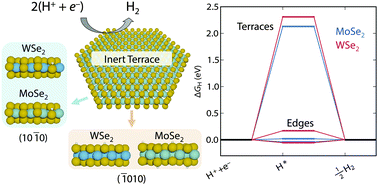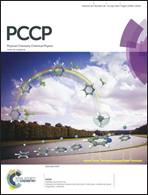Active edge sites in MoSe2 and WSe2 catalysts for the hydrogen evolution reaction: a density functional study†
Abstract
MoSe2 and WSe2 nanofilms and nanosheets have recently been shown to be active for electrochemical H2 evolution (HER). In this work, we used periodic density functional theory to investigate the origin of the catalytic activity on these materials. We determined the relevant structures of the Mo/W-edges and the Se-edges under HER conditions and their differential hydrogen adsorption free energies. The Mo-edge on MoSe2 and the Se-edge on both MoSe2 and WSe2 are found to be the predominantly active facets for these catalysts, with activity predicted to be comparable to or better than MoS2. On the other hand, the (0001) basal planes are found to be inert. We further explain the enhanced activity at the edges in terms of localized edge states, which provide insight into the trends in HER activity seen between the two catalysts. Our results thus suggest that an optimal catalyst design should maximize the exposure of edge sites. Comparisons are also made between the transition metal selenide catalysts and their sulfide counterparts in order to understand the consequences of having either Mo/W or Se/S atoms. It is found that linear scaling relations describe the S/Se binding onto the edge and the H binding onto the S/Se.


 Please wait while we load your content...
Please wait while we load your content...